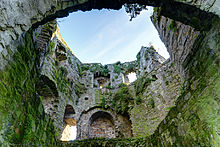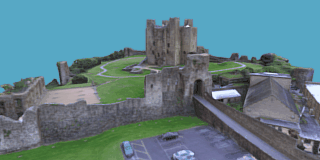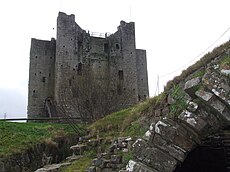Trim Castle
This article has multiple issues.Please helpimprove itor discuss these issues on thetalk page.(Learn how and when to remove these messages)
|
| Trim Castle | |
|---|---|
| Trim,County Meath,Ireland | |
 The keep and curtain walls of Trim Castle | |
| Coordinates | 53°33′18″N6°47′23″W/ 53.555°N 6.7897°W |
| Type | Medieval castle |
| Site information | |
| Owner | Currently theIrish Governmentthrough theOffice of Public Works |
| Condition | Ruin |
| Site history | |
| Built | from the 12th century |
| Built by | Hugh de Lacy (keep) |
| In use | Open to public |
| Official name | Trim Castle |
| Reference no. | 514 |
Trim Castle(Irish:Caisleán Bhaile Átha Troim) is acastleon the south bank of theRiver BoyneinTrim, County Meath,Ireland, with an area of 30,000 m2.[1][2]Over a period of 30 years, it was built byHugh de Lacyand his sonWalteras thecaputof theLordship of Meath.TheIrish Governmentcurrently own and are in charge of the care of the castle, through the state agency TheOffice of Public Works(OPW).
The castle is on theList of National Monuments in County Meath.[3]
History
[edit]De Lacy
[edit]The land area of Meath was owned by the church but was granted toHugh de Lacyin 1172 byHenry II of Englandas one of the new administrative areas.[4]De Lacy built a huge ringwork castle defended by a stout double palisade and external ditch on top of the hill. There may also have been further defences around the cliffs fringing the high ground. Part of a stone footed timber gatehouse lies beneath the present stone gate at the west side of the castle.

The site was chosen because it is on raised ground, overlooking a fording point on theRiver Boyne.The area was an important early medieval ecclesiastical and royal site that was navigable inmedieval timesby boat up the River Boyne, about 25 miles from theIrish Sea.Trim Castle is referred to in theNormanpoemThe Song of Dermot and the Earl.
De Lacy left Ireland entrusting the castle toHugh Tyrrel,baron ofCastleknock,one of his chief lieutenants. The ringwork was attacked and burnt by forces of theGaelicHigh King of Ireland,Ruaidrí Ua Conchobair;Tyrrel, having appealed in vain for help, was forced to flee. Ua Conchobair soon withdrew and De Lacy, orRaymond FitzGerald,immediately repaired or rebuilt the castle in 1173. After Hugh's death in 1186 his sonWalter de Lacysucceeded as Lord of Meath.[5]He continued rebuilding and the castle was completed in the 1220s, most likely in 1224. The year when construction was completed was considered to be 1220 by historians in the 19th century but that is now in dispute.[6]
Geneville and Mortimer
[edit]The next phase of the castle's development took place at the end of the 13th century and the beginning of the 14th century; a new great hall (with undercroft and attachedsolarin a radically altered curtain tower), a new forebuilding, and stables were added to the keep.
On Walter de Lacy's death in 1241 his granddaughterMathilda('Maud') inherited the castle. Her second husband wasGeoffrey de Geneville(brother of the crusade historianJean de Joinville),[7]Lord ofVaucouleursinChampagne,France, and of many lordships in England and Ireland which were to devolve upon his heirs. His son Piers de Geneville (who marriedJoan de Lusignan) died in 1292 leaving a daughterJoan,who in 1301 marriedRoger Mortimer (1st Earl of March).[8]Mathilda having died in 1304, in 1308 Geoffrey conveyed his Irish lordships to Roger Mortimer, and entered theprioryat St. Mary's in Trim. Joan Mortimer inherited the title Baroness Genevillesuo jurewhen Geoffrey died in 1314.[9]
The castle thereby passed to the Mortimer family who held it until 1425, when the male line died out withEdmund Mortimer, 5th Earl of March.[10]After this the estate passed toRichard of York,son of Edmund's sisterAnne MortimerbyRichard of Conisburgh, 3rd Earl of Cambridge.[11]Richard of York was killed at theBattle of Wakefieldin 1460, and in 1461 his son, KingEdward IV,appointed Germyn Lynch, goldsmith of London, to be his representative at Trim as warden and master worker of the new issues of moneys and coins within the Castles of Dublin and Trim, and the town of Galway.[12]
Later ownership
[edit]
During the 15th century theIrish Parliamentmet in Trim Castle seven times and a mint operated in the castle. It was at that time the centre of administration for Meath and marked the outer northern boundary ofThe Pale.In the 16th century it fell into decline and was allowed to deteriorate, but it was refortified during theIrish Confederate Warsin the 1640s. In 1649 after thesacking of Drogheda,the garrison of Trim fled to join otherIrish forcesand the place was occupied by thearmyofOliver Cromwell.
After the wars of the 1680s, the castle was granted to the Wellesley family who held it untilArthur Wellesley (the Duke of Wellington),sold it to the Leslies. In following years it passed via the Encumbered Estates Court into the hands of theDunsanyPlunketts. They left the lands open and from time to time allowed various uses, with part of the Castle Field rented for some years by the Town Council as a municipal dump, and a small meeting hall for the Royal British Legion erected. The Dunsany held the Castle and surrounds until 1993, when after years of discussion, Lord Dunsany sold the land and buildings to the State, retaining only river access and fishing rights.
Restoration
[edit]TheOffice of Public Worksbegan a major programme of exploratory works and conservation, costing in the region of 4.5 million euro, including partial restoration of the moat and the installation of a protective roof on the keep. The castle was re-opened to the public in 2000.
Structure
[edit]With an area of 30,000 m2,Trim Castle is the largestCambro-Normancastlein Ireland. The design of the central three-storeykeep(also known as a donjon or great tower) is unique for a Norman keep being ofcruciformshape, with twenty corners. It was built on the site of the previous large ring work fortification in at least three stages, initially by Hugh de Lacy (c. 1174) and then in 1196 and 1201–5 byWalter de Lacy. The castle interior was partially the subject of archaeological digs, by David Sweetman of theOPWin the 1970s, and more extensively by Alan Hayden in the 1990s.
The survivingcurtain wallsare predominantly of three phases. The west and north sides of the enceinte are defended by rectangular towers (including the Trim Gate) dating to the 1170s; the Dublin gate was erected in the 1190s or early part of the 13th century; and the remaining wall to the south with its round towers dates to the first two decades of the 13th century. The castle has two main gates. The one in the west side dates to the 1170s and sits on top of a demolished wooden gateway. The upper stories of the stone tower were altered to a semi-octagonal shape, c. 1200. The Dublin Gate in the south wall is a single round towered gate with an externalbarbicantower. It dates from the 1190s or early 13th century and was the first example of its type to be constructed in Ireland.[citation needed]

Apart from the keep, the main extant structures consist of the following: an early 14th-century three-towered fore work defending the keep entrance and including stables within it (accessed by a stone causeway crossing the partly filled-in ditch of the earlier ringwork); a huge late 13th-century three-aisled great hall (with an under croft beneath its east end opening via a water gate to the river); a stout defensive tower (turned into a solar in the late 13th century at the northern angle of the castle); a smaller aisled hall (added to the east end of the great hall in the 14th or 15th century); a building (possibly the mint) added to the east end of the latter hall; two 15th- or 16th-century stone buildings added inside the town gatehouse, 17th-century buildings (added to the end of the hall range and to the north side of the keep) and a series of lime kilns (one dating from the late 12th century, the remainder from the 18th and 19th centuries).
Access
[edit]TheOffice of Public Worksoperate a Guide Service at Trim Castle and the grounds are open to the public for self-guiding, on payment of an entry fee. Access to the Castle keep is by guided tour only, an entry fee also applies. In winter, the complex is open only on weekends and bank holidays.
Popular culture
[edit]
The 1980 movieThe Big Red One,starringLee MarvinandMark Hamill,was also partially shot in Trim and in particular at Trim Castle.
The castle is noted for the part it played in the filming ofMel Gibson's filmBraveheart.The castle was presented as the walled city of York; scenes that took place in London were also filmed here.[13]
Controversies
[edit]In 2003 there was a controversy surrounding the decision by theMinister for the Environment, Heritage and Local GovernmentMartin Cullennot to oppose the construction of a five-storey hotel across the road from the castle. The development had been condemned by a local councillor, a senior inspector in An Bord Pleanála (acting in a private capacity, and later choosing to withdraw his appeal lest it be considered a conflict of interest) and heritage bodies, many of whom had been critical of the government's treatment of other heritage sites such asCarrickmines Castle(the ruins of which were excavated partly to allow the completion of a roadway).[14]The hotel was opened in August 2006.
The recent addition of buildings outside the west side of the town has further intruded on the castle remains.
See also
[edit]References
[edit]- ^Trim Castle, Meath Tourism-Ireland.http:// meath.ie/Tourism/Heritage/HeritageSites/TrimCastle/
- ^Heritage Ireland: Trim Castle."Heritage Ireland: Trim Castle".Archived fromthe originalon 23 May 2013.Retrieved23 May2013.
- ^ME01634 MANORLAND (1ST DIVISION) TRIM CASTLE
- ^'Trim Castle', in R. Butler,Some Notices of the Castle and of the Ecclesiastical Buildings of Trim, led from various authorities(Hodges, Smith & Co., Dublin 1861), pp. 9-134, atpp. 13-14andpp. 238-39(Internet Archive).
- ^Butler,Some Notices,pp. 14-17.
- ^ME01634 MANORLAND (1ST DIVISION) TRIM CASTLE
- ^Butler,Some Notices,p. 27(Internet Archive).
- ^Butler,Some Notices,pp. 29-30.
- ^Butler,Some Notices,pp. 30-33.
- ^Duchas the Heritage Service (ed) (2002).Trim Castle Co. Meath.pp. 20–26.ISBN0-7557-1282-X.
{{cite book}}:|last=has generic name (help) - ^Butler,Some Notices,pp. 67-72(Internet Archive).
- ^Butler,Some Notices,pp. 80-82(Internet Archive).
- ^Trim Castle Cinematic View
- ^Withdrawal of appeal against hotel in Trim to be challenged 7 November 2000
Sources
[edit]- Reeves-Smith, Terrence. 1995.Irish Castles.Belfast: The Appletree Press Ltd.
- De Breffny, Brian. 1977.Castles of Ireland.London: Thames and Hudson.
- Salter, Mike. 1993.Castles and Strong Houses of Ireland.Worc.: Folly Publications.
- Sweetman, David. 1999.The Medieval Castles of Ireland.Cork: The Collins Press.
- McNeill, Tom. 1997.Castles in Ireland.London: Routledge.
Further reading
[edit]- Sweetman, P. D. (1998),"The development of Trim Castle in the light of recent research",Château Gaillard: Études de castellologie médiévale,XVIII:223–230,ISBN9782902685059
- Hayden, A.R (2011) Trim Castle, Co Meath: Excavations 1995–8. Archaeological Monograph Series: 6. Wordwell (Bray) & Stationery Office (Dublin).
External links
[edit]- Meath Tourism on Trim Castlewebsite by Meath County Council
- Heritage of Ireland on Trim Castle
- Translation of Grimm's Saga No. 10 The Ghost of Boyne Castle
| External 3D model | |
|---|---|
 | |
- Buildings and structures completed in 1224
- Castles in County Meath
- Norman architecture in Ireland
- Ruins in the Republic of Ireland
- Archaeological sites in County Meath
- National monuments in County Meath
- Historic house museums in the Republic of Ireland
- Museums in County Meath
- Trim, County Meath
- De Lacy family
- Lime kilns in Ireland




